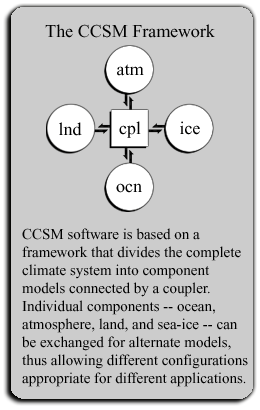CPL Version 6.0
The CCSM coupler, version 6.0 (cpl6), was released in June 2004 as part of the CCSM3.0 release.
Documentation
- User Documents: Combined User's Guide, Source Code Reference, and Scientific Description [HTML] [PDF] [PS](Latest version: June 23, 2004)
- Other Documents: CPL6 API Reference Manual [HTML] [PDF] [PS] (Latest version: July 5, 2004)
Information on libraries used by cpl6:
What is a "coupler"?
 CCSM coupled model is based on a framework which divides the complete climate system into component models connected by a coupler. This design requires four component models -- atmosphere, sea-ice, land, and ocean -- each connected to the coupler, and each exchanging data with the coupler only. This "hub-and-spoke" method of building a coupled model is pictured at the right.
CCSM coupled model is based on a framework which divides the complete climate system into component models connected by a coupler. This design requires four component models -- atmosphere, sea-ice, land, and ocean -- each connected to the coupler, and each exchanging data with the coupler only. This "hub-and-spoke" method of building a coupled model is pictured at the right.
The CCSM is not a particular climate model, but a framework for building and testing various climate model configurations for various applications. This CCSM distribution contains several active and data models which can be combined into different coupled models. The one constant in this multi-model system is the Coupler.
The Coupler hub has several key functions within the CCSM framework:
- It allows the CCSM to be broken down into separate components, atmosphere, sea-ice, land, and ocean, that are "plugged into" the coupler. Each component model is a separate code that is free to choose it's own spatial resolution and time step. Individual components can be created, modified, or replaced without necessitating code changes in other components. CCSM components run as separate executables, communicate via message passing (MPI in particular), and can be distributed among several computers.
- It controls the execution and time evolution of the complete CCSM by synchronizing and controlling the flow of data between the various components.
- It communicates interfacial fluxes between the various component models while ensuring the conservation of fluxed quantities. For certain flux fields, it also computes interfacial fluxes between the various component models (based on state variables).